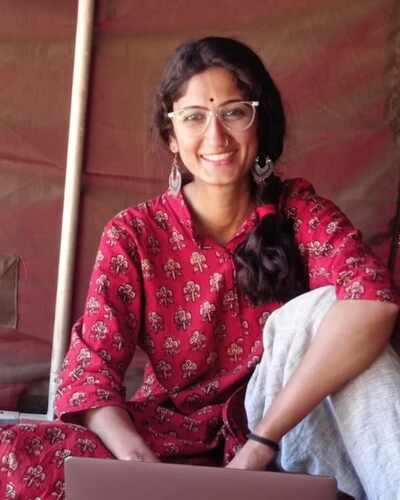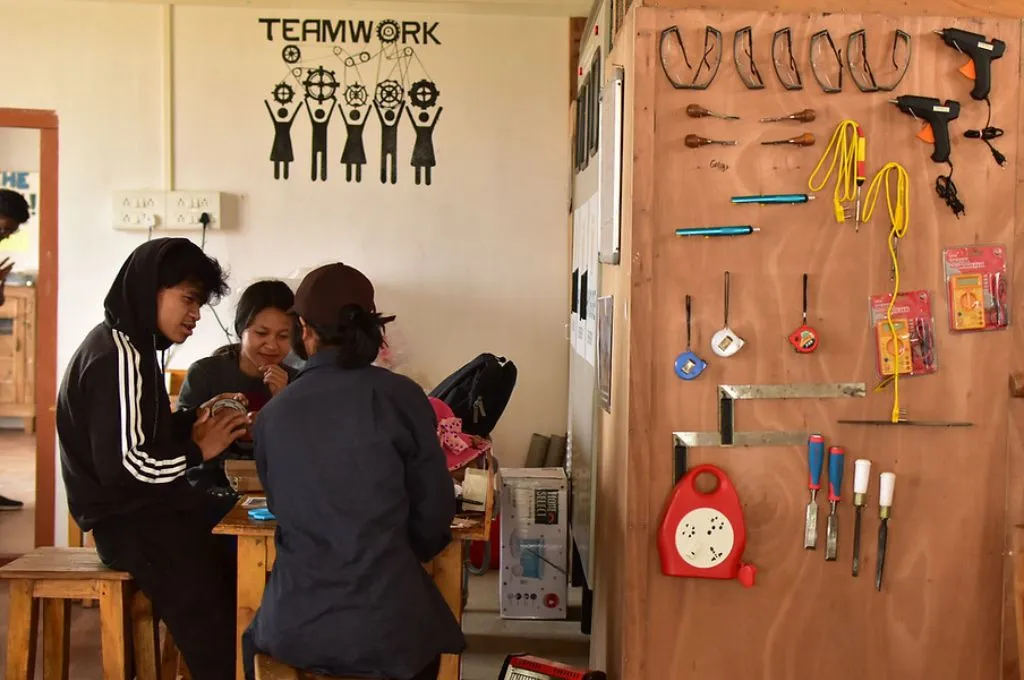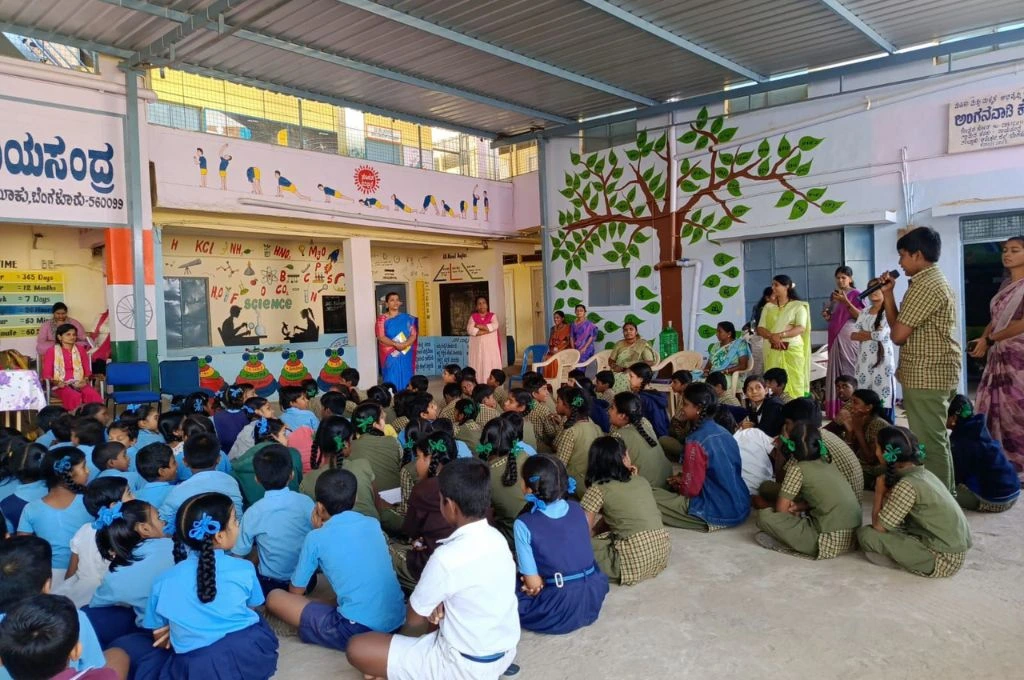Launched in 2006, the Mahatma Gandhi National Rural Employment Guarantee Scheme (MGNREGA) legally recognises people’s right to work. It was envisioned as a way to deal with rural unemployment, poverty, and distress migration by guaranteeing 100 days of labour to each household with a job card. MGNREGA is a rights-based legislation that provides basic income to any working-age person from rural India, where people often don’t have sustainable work opportunities.
In the last few years, the budget allocations for MGNREGA have either gone down or remained unchanged, even as demand has gone up. Apart from the budget cuts, policymakers, academics, and civil society organisations have pointed out other issues with MGNREGA: low wages that are in need of revision, a push for technology and the deletion of workers’ names from the database, and problems with the management of the scheme by the Union government. In addition, the Centre—which takes care of the materials cost—owes INR 6,366 crore to the states. Given all of these challenges, some have also wondered if a cash transfer scheme might do the same job.
But what are the perspectives from the ground? What do the people who are really involved in MGNREGA—workers, unions, and civil society organisations working with them—think about it? What sort of changes has it spelled for people who have availed of it? And how do people feel about it on the grassroots?

The realities and experiences of MGNREGA workers differ in different rural contexts. IDR spoke to organisations and individuals who work on the law’s implementation in different parts of Rajasthan. These include Aajeevika Bureau, members of Rajasthan Asangathit Mazdoor Union (RAMU), and Gramin evam Samajik Vikas Sansthan (GSVS). Across the board, it was felt that MGNREGA is still a necessity in rural Rajasthan, which is a drought-prone region and lacks livelihood opportunities. Projects under MGNREGA in the state have included water conservation, drought proofing, and rural connectivity, contributing to an increase in sustainable agriculture and development.
Many people we spoke to, including organisation leaders, MGNREGA mates (worksite supervisors), and workers, across Rajsamand, Beawar, and Ajmer districts emphasised the continuing need for the scheme within rural, marginalised sections of society.
These are some of the reasons for its relevance and popularity with workers:
1. Livelihood options
In places such as Kumbhalgarh in Rajasthan’s Rajsamand district, the combination of geography with the lack of industry results in limited daily wage labour opportunities. Given the hilly terrain and rocky land, a very small percentage of the land here is fit for agriculture. Only approximately 28 percent of Rajsamand district is cultivable, and in the Kumbhalgarh area, this figure drops even lower. Although Kumbhalgarh is seeing a tourism boom due to the Kumbhalgarh Fort and the town’s proximity to Haldighati, hospitality jobs are only open to those with formal education.
Approximately 78 percent of the workers in southern Rajasthan migrate to other states in search of work.
According to Dharmraj Gurjar, who works with Aajeevika Bureau, “The main source of wage labour is construction, where those with more skill (for example, carpentry or painting) get INR 500–550 per day, while the rest earn INR 250–300 a day.” Other than these options, there is MGNREGA.

“At one point, when the population was lower, perhaps there was sufficient opportunity to make a livelihood here. But there are not nearly enough jobs in Rajsamand now,” he adds. This makes migration a very popular option. “We have a saying here,” says Manju Rajput, who works with Aajeevika’s adolescent and women programme in the Rajsamand and Udaipur area, “Pass hua to zindabad, fail hua to Ahmedabad.” (If you graduate, then you’ll flourish. Else, you’ll end up [migrating] to Ahmedabad.) According to a 2014 study by Aajeevika, approximately 78 percent of the workers in southern Rajasthan migrate to other states in search of work. “Financial conditions have deteriorated since the pandemic, so now people have started taking their entire families.”
Migration also starts early and is cyclical in nature—often the males in the next generation of the same family migrate to work when one generation of men returns. Manju adds, “Boys as young as 13–15 migrate in search of work. They’ll work for two decades or so, usually in restaurant kitchens, as hamaals or load carriers, in construction work, among other occupations—and then return. But even though people are usually productive in their thirties, these migrants who have returned are completely burnt out by then because of the physically demanding nature of the work and the long hours.” After their return, burnout and the lack of skills necessary for availing other opportunities in the local job market leaves the next generation with no choice but to migrate and contribute to the household income.
Kamla Devi, a MGNREGA worker who is also a member of Aajeevika’s Ujaala Samooh, asserted that the whole family works to earn—income from agriculture, which is usually not mechanised at all and thus requires all hands on deck; MGNREGA work; and migrant work by younger male family members combined keeps the household financially afloat. Therefore, the guaranteed work that MGNREGA provides becomes essential to the household income.
Moreover, in an attempt to uplift the economic situation of historically marginalised communities, in 2011, the Rajasthan government notified that particularly vulnerable groups will receive 200 days of work under the rural guarantee scheme, with the excess expenditure being covered by the state government. Kherua and Sahariya Adivasis of Baran district and Kathaudi Adivasis of Udaipur are among those who benefit from this addition. But even though MGNREGA is a lifeline for these communities, which have traditionally been subjected to bonded labour, it is rare for them to receive the complete 200 days of work.
Suresh Sahariya, a mate from Baran, says, “MGNREGA has saved the Sahariyas from the difficulties of migration and from working on extremely low wages on other people’s lands. While it has been nearly impossible for most to avail the extra 100 days of work, which we continue to fight for as our right, without MGNREGA it would be difficult for us to get dignified work because of social and economic discrimination.”
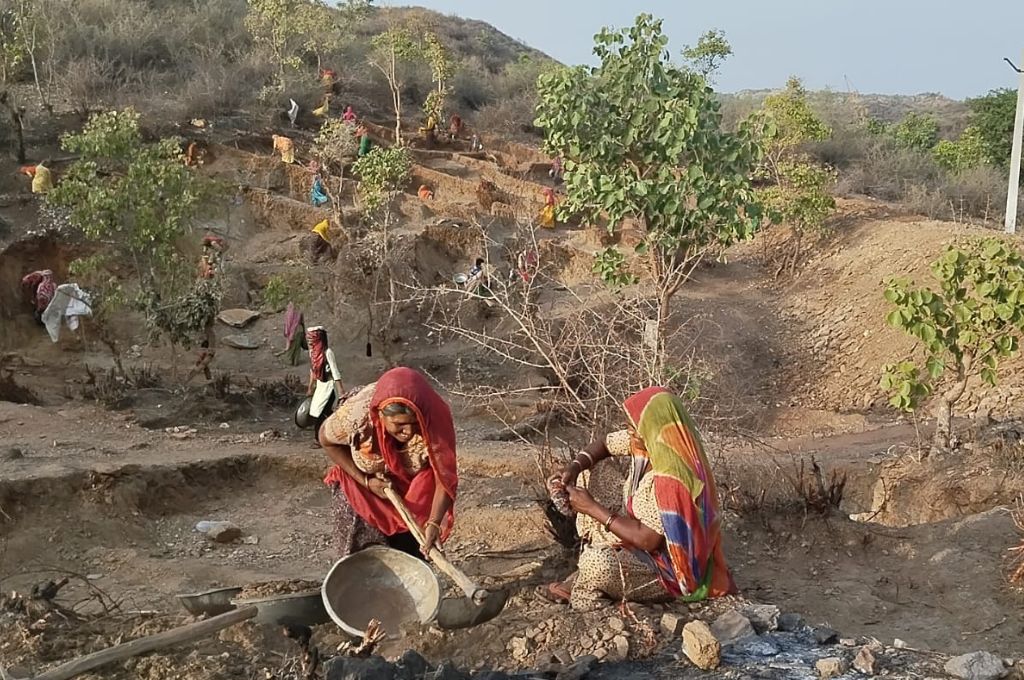
2. Women’s empowerment
MGNREGA brings to the fore themes related to women and gender issues—gender equality, social power dynamics, control over income, labour drudgery, mobility, decision-making in both village and household settings, and public leadership. All over India, women make up 57.43 percent of the MGNREGA labour force, and other than in 2020–21, this number has risen consistently. This is so even when the female labour force participation rate in India seems to have stagnated overall.
There are two ways in which the women we spoke with feel empowered.
Increase in economic agency
When men migrate, they usually leave women and their families behind. MGNREGA has been a way for women to participate in the workforce and earn income that they have control over. In fact, the female labour force participation rate in MGNREGA has constantly increased, especially in Rajasthan where this figure sits at 68.17 percent.
Kamla Devi tells us that with MGNREGA, women are able to take care of their domestic chores as well as agricultural work, if there is any. “Under MGNREGA, we don’t have to stay on for a fixed number of hours and we can leave as soon as the quota of work is done.” While this doesn’t hold true across India, many civil society organisations and labour rights groups have pressured the state and local government bodies to let workers leave after completing the quota of work allotted, instead of staying for eight hours.
In Beawar, home to several mineral crushing factories, MGNREGA has impacted women’s lives in a different, and perhaps clearer, manner. Rajesh Dhodawat, a programme officer with GSVS in Beawar, says, “Daily wage labourers in Beawar consist of both local residents and migrant workers from states like Bihar. Given that the main source of income here was the stone crushing factories, both local and migrant labour—with the former comprising many women since Rajasthani men migrate to other states themselves—were competing for the same jobs.” This created a surplus of labour, due to which workers were left with little bargaining power as far as wage rates and working conditions were concerned.
Women feel they have a say in decision-making since they are contributing to the household income.
With the introduction of MGNREGA, however, local women chose this work over factory work for many reasons: proximity to their homes, competitive wage rate but with less hazardous working conditions, and the ability to do MGNREGA work alongside domestic and agricultural work.
More importantly, women feel they have a say in decision-making since they are contributing to the household income. Some of the women told us, “It is easier to take care of our children. And when our incomes get added to our husbands’, it is easier to run the household.” Women whose husbands are disabled or have succumbed to health issues like silicosis (which is common in the area but is under-documented) also point out that MGNREGA adds to the pensions they receive. When women work, they’re more likely to spend on children’s health and education. There are studies that indicate that this has been the case with MGNREGA too.
Having a community space
Women in rural areas of Rajasthan manage their homes; perform domestic chores such as cooking, cleaning, getting water, and preparing meals; and also undertake grazing and agricultural work—all of which are relatively solitary tasks. At a MGNREGA site, the workers are predominantly women, so they feel that they can interact more freely. Ujaala Samooh, RAMU, and GSVS intentionally work closely with women MGNREGA labourers, mates, mobilisers, and block coordinators of unions/groups. This is not only to build women’s local leadership, but also because of the advantages of a space that is majority women and girls.
Kamma Devi, a MGNREGA worker of Rajsamand district, told us, “Women don’t have a space to meet without male supervision. At the MGNREGA site, we have the opportunity to go outside our homes, and are able to openly speak to one another. When we come together, we make jokes, share food, discuss our family problems as well as village and panchayat issues, and sometimes even sing folk songs.”
3. Local development
The labour that is performed under MGNREGA goes towards the creation of assets for the village. In Rajasthan, for instance, MGNREGA has been used to modernise tankas (ponds) to reduce water scarcity. Manju adds, “The roads that are built, and the work that people do, are usually also a boost for workers because they feel that their village’s infrastructure is being developed.”
A common charge that is levied is that the assets thus created are of low quality, and that the work itself—which has been equated with digging ditches—is not productive. However, this is not necessarily true. An impact assessment of MGNREGA assets by the UNDP shows that they lead to income generation, shifts to more remunerative agricultural practices, and the creation of water harvesting and other structures that are useful for the village.
Shankar Singh, co-founder of Mazdoor Kisan Shakti Sangathan, talks about the effects of MGNREGA on the local economy with some back-of-the-envelope maths. “Take the example of Bhim, where there are 2,000 registered workers. If all of these workers get poora kaam, poora daam (125 days of work at the full rate of INR 255), you’re adding more than INR 6 crore to the local economy of Bhim. And where is that money going? It’s going to the petty shopkeepers here.”
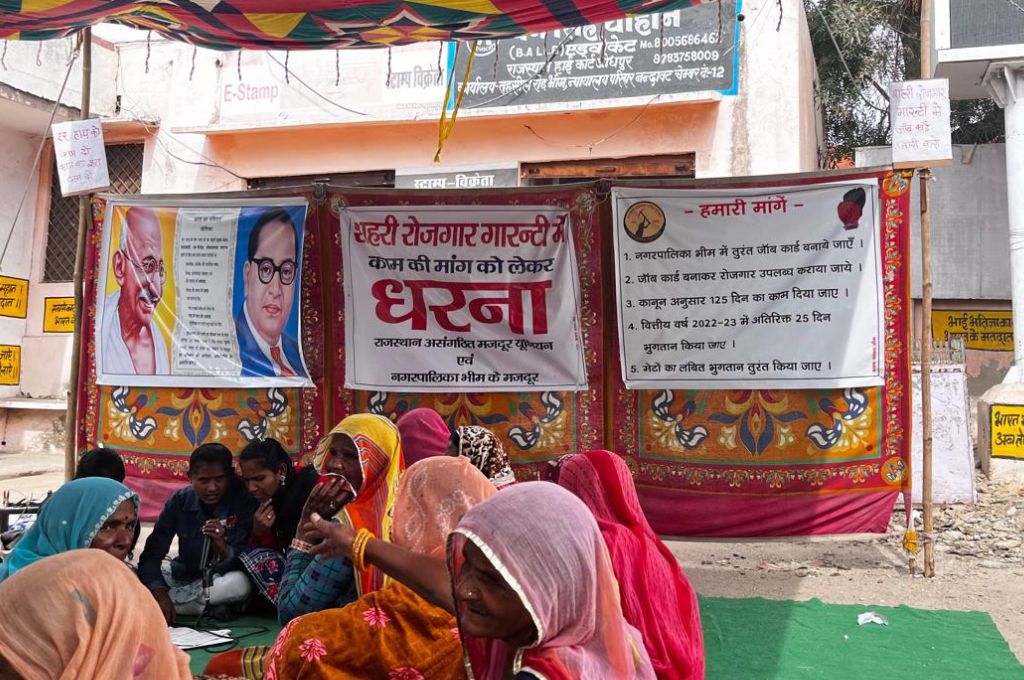
MGNREGA is not free from problems
The employment guarantee legislation is considered indispensable by both the MGNREGA workers and civil society organisations that have been working on labour and related issues. Despite this, the legislation faces numerous problems that impact its effectiveness and the livelihoods of workers.
One significant issue is the reluctance of the panchayat sachiv (village development officer) and sarpanch to issue job cards, often citing budgetary constraints. Additionally, not everyone who applies for a job card receives one. Beena Chauhan, who works with GSVS as a community mobiliser in Beawar, says that getting MGNREGA work started in the villages around the town wasn’t easy. “In the first panchayat we went to, the sarpanch was extremely hesitant. Even when one panchayat started issuing job cards and we moved on to the next one, the sarpanch there tried to rally the menfolk against this, saying, ‘Today they’re asking for this, tomorrow it will be something else.’”
On average workers receive only approximately 45 days of work.
Masked behind this gendered discrimination is also corruption, asserts Ishwar Singh, former block coordinator of RAMU. “Many a time the sarpanch, the sachiv, other government officials, and the contractors they hire do not have the will to actually work, as this would necessitate sitting in the panchayat office the whole day, prepare muster rolls, conduct audits of the work done under MGNREGA, etc. They would rather cut corners.” Even when job cards are issued, a full 100 days of work are often not available, and workers may not receive full pay for the work they do. “Say the Union government sends you one roti per person. But by the time this roti reaches you, only a bite is left. In the middle, government officials, thekedars, and other middlemen have eaten their fill. This is what happens to the MGNREGA budget by the time it reaches the ground.”
Corruption in the system is rampant. Workers frequently struggle to secure work after they demand it, as their name either does not appear in the muster rolls, or they receive fewer than the guaranteed 100 days a year. On average, according to Manju and others we spoke to, workers receive only approximately 45 days of work. Administrative barriers, such as the requirement to open bank accounts and use the NMMS app to mark attendance, also hinder workers from signing up for or getting paid for work.
The extent of these problems and how the local community tackles them varies by location. For example, in villages in Beawar district too, getting the full number of person-days of work allotted under the scheme and also being paid the full amount has met with roadblocks. When an area’s designation changes from rural to urban, MGNREGA does not apply to it any more as the scheme provides employment guarantee only in rural areas. Therefore, women workers in Bhim were found protesting earlier this year—Bhim was reclassified from a gram panchayat to a nagar palika (municipality), and the Indira Gandhi Shehari Rozgar Yojana (urban employment guarantee scheme) had not yet been implemented there. In this way, workers in both Bhim and Beawar use protests to voice their demands.
It is necessary to acknowledge these ground-level problems and understand the workers’ perspectives so that challenges can be addressed effectively and the implementation of MGNREGA can be improved.
—
Know more
- Read this article to learn more about MGNREGA and its implementation.
- Watch this video to learn how MGNREGA contributes to ecological security in rural Rajasthan.
- Read this article to learn how systemic challenges in Odisha have resulted in poor uptake of MGNREGA, especially among women.

